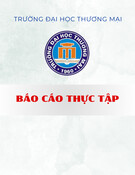
MINISTRY OF EDUCATION AND TRAINING
DONG THAP UNIVERSITY
FOREIGN LANGUAGE DEPARTMENT
B.A THESIS PROPOSAL
THE REALITY OF PRACTICING LISTENING SKILL
OF THE THIRD-YEAR MAJORED ENGLISH
STUDENTS AT DONG THAP UNIVERSITY BASING ON
THE FORMAT OF THE IELTS LISTENING TESTS
STUDENT: NGUYEN CHAU MINH THU
Dong Thap
September 24th , 2012

MINISTRY OF EDUCATION AND TRAINING
DONG THAP UNIVERSITY
FOREIGN LANGUAGE DEPARTMENT
B.A THESIS PROPOSAL
THE REALITY OF PRACTICING LISTENING SKILL
OF THE THIRD-YEAR MAJORED ENGLISH
STUDENTS AT DONG THAP UNIVERSITY BASING ON
THE FORMAT OF THE IELTS LISTENING TESTS
STUDENT : NGUYEN CHAU MINH THU
SUPERVISOR: HUYNH CAM THAO TRANG, M.A
Dong Thap
September, 24th , 2012

i
DECLARATION
I certify that the thesis entitled “The reality of practicing listening skill
of third-year majored English students at Dong Thap university basing on the
format of the IELTS listening tests” has been performed and interpreted
exclusively by myself. I clarify that the work is submitted in partial fulfillment
of the BA degree requirements and has not been submitted elsewhere in any
other forms for the fulfillment of any degrees or qualification.
Dong Thap, November 2012
Nguyen Chau Minh Thu

ii
ACKNOWLEDGEMENTS
During the process of carrying out the study, I have received a large
amount of contribution and support from many people.
First of all, I would like to send my sincere warm thanks to my
supervisor, Huynh Cam Thao Trang, M.A. for her enthusiastic and useful
supervision, insightful comments, and encouragement without which my
thesis would not have been completed.
Next, I would like to express my greatest to the Dean and all lectures of
the Foreign Languages Department of Dong Thap university who gave me a
chance to carry out this study.
Thirdly, I am grateful to Mr. Le Nhut Long and Mr. Pham Van Tac
who did give me the mid-term tests helped me to have a general look of the
format of the tests and all the students in the Department of Foreign
Languages for what they have done to help me finish the study.
Finally, my special thanks are especially sincerely sent to my parents,
my friends and others who always stay by my side and give me useful advices
as well as spiritual support.

iii
ABSTRACT
The study is conducted to investigate the reality of practicing listening
skill of third-year majored English students at Dong Thap university basing on
the IELTS listening test format. The data of the study includes 2 kinds. Firstly,
there are 50 questionnaire sheets with 3 parts, including 9 questions for 50
students. The questionnaire was delivered to find information and attitude
about the self-study of third-year students. The second kind of data is 4 mid-
term test sheets that are collected from teachers of listening skill. Then the
questionnaire and mid-term test sheets are analyzed. Statistic, Comparing and
contrasting are 2 main methods of this study. Then the data obtained from the
above tools is analyzed including table charts, bar charts and discussions. The
aims of this study are to find 1) how many percent IELTS listening part are
there in the mid-tests of third-year majored English students at Dong Thap
university 2) do the students prepare for IELTS listening test. To judge from
the results of the analysis, IELTS just makes up with 12.50 % of 4 tests. 74 %
of students want to get IELTS certificate. 46% of third-year students spend 30
minutes and 30% of them spend 1 hour practicing listening every day. They
have regarded to IELTS listening.
In short, the data gained from the students and the tests from teachers
confirmed that the format in the IELTS test is essential to them.






![Báo cáo seminar chuyên ngành Công nghệ hóa học và thực phẩm [Mới nhất]](https://cdn.tailieu.vn/images/document/thumbnail/2025/20250711/hienkelvinzoi@gmail.com/135x160/47051752458701.jpg)









